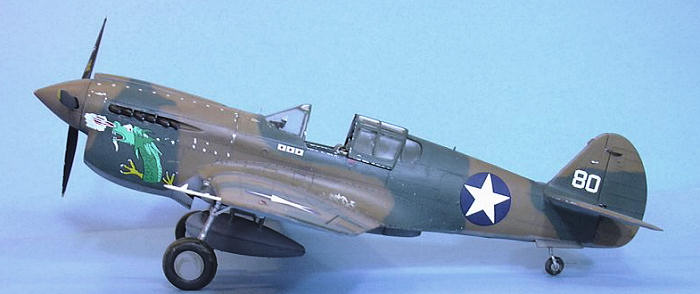
| KIT #: | 09086 |
| PRICE: | $49.95 MSRP |
| DECALS: | Three options |
| REVIEWER: | Tom Cleaver |
| NOTES: |

| HISTORY |
Perhaps the most important fighter group in the
USAAF during the Second World War was the 49th
Fighter Group. The influence of this unit as a result of the experience gained
during its first year of combat in the Southwest Pacific on the rest of the
USAAF 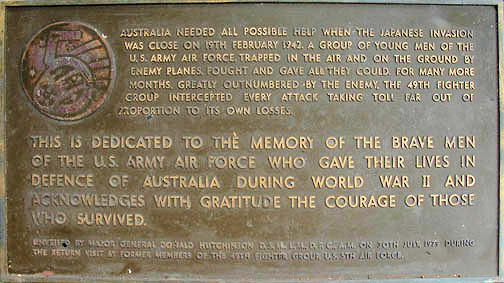 throughout
the remainder of the war is of crucial importance. A list of 49th
Fighter Group pilots from this period who went on to be important leaders of the
USAAF includes some of the most important names in USAAF history.
throughout
the remainder of the war is of crucial importance. A list of 49th
Fighter Group pilots from this period who went on to be important leaders of the
USAAF includes some of the most important names in USAAF history.
The record of the 49th Fighter Group in combat - when they were the first line of defense of Australia against Japanese invasion and then the leading unit in the offensive against the Japanese in New Guinea - is a one of achievement in the face of overwhelming odds. It is a record that places the 49th Fighter Group on the same list as the 23rd and 4th Fighter Groups - the former American Volunteer Group and the Eagle Squadrons.
The "49'ers" began life as part of the struggle by the Air Corps to expand into the organization everyone knew would be needed in the war all saw coming. Major Glen Davasher took command of the newly-organized 49th Pursuit Group on November 20, 1940 at Selfridge Air Base. The unit was formed from cadre from the 94th Pursuit Group, and the three squadrons were the 7th "Screamin' Demons" Squadron, the 8th "Blacksheep" Squadron and the 9th "Flying Knights" Squadron.
The unit transferred to Morrison airfield at West Palm Beach in May 1941, where the weather was better for the training the pilots needed.
In the aftermath of the attack on Pearl Harbor, Major Paul "Squeeze" Wurtsmith took command on December 12, 1941. The men knew they were going into combat - the only question was when they would leave and where they would go. Rumors spread as they were notified at the end of the month to prepare for overseas deployment that they were would reinforce the Philippines.
The 49th traveled by train to San Francisco, arriving on January 8. They were put up in the County Livestock Pavilion, better known as the "Cow Palace," where 75 new pilots and 587 enlisted men ought the unit to full authorized strength.
On January 12, the 49th Pursuit Group boarded the transports Mariposa and Coolidge, while their heavy equipment was loaded aboard the freighter Luckenbach. The convoy headed out under the Golden Gate Bridge at mid-day. Two hours later, out of sight of land, they rendezvoused with the light cruiser USS Phoenix, and set course toward the western Pacific.
The rumors had been right. They were bound for the Philippines. Following MacArthurís evacuation of Manila and retreat to Bataan, their destination was changed to Melbourne, Australia. On January 31 they sighted the Australian coastline at Cape Howes, and arrived in Melbourne on February 1. The 49th Pursuit Group was the first American unit to arrive in Australia as a complete unit. Australia was nervous, as was everywhere else in Southeast Asia as the Japanese stormed south, smashing all opposition.
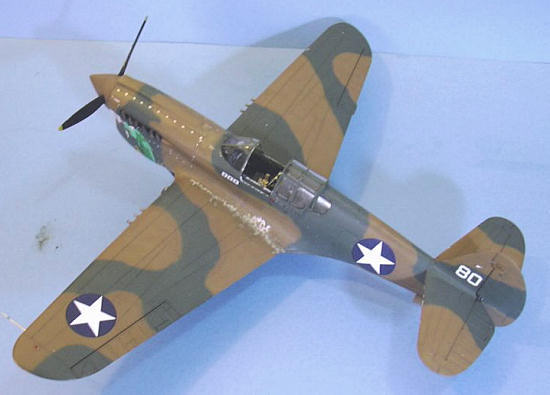 When
Wurtsmith reported to headquarters, he found he was now a Lt. Col., and his
squadron commanders were all Captains. After Australian longshoremen refused to
unload the ships, the officers and men spent three days unloading their supplies
and equipment by hand.
When
Wurtsmith reported to headquarters, he found he was now a Lt. Col., and his
squadron commanders were all Captains. After Australian longshoremen refused to
unload the ships, the officers and men spent three days unloading their supplies
and equipment by hand.
Darwin was soon the front line following the defeat in the Netherlands East Indies. The plan was that the group would fly to Brisbane on the east coast, on to Charleville, to Cloncurry in Queensland and finally on to Darwin. The route was known as "the Brereton Route" and was 3,600 miles long. It was later described to a pilot of the 49th: "You won't have any trouble finding your way to Darwin. Just follow the trail of crashed Kittyhawks, you can't go wrong."
The Japanese threat to Darwin became reality with the first raid on February 19, a week after the sinking of USS Langley during her attempt to reinforce Java. This carrier-based raid was followed after the Japanese invasion of Timor on February 20, 1942, by sustained raids of G4M Betty bombers, escorted by Zeros. After a week of raids, an advance team of the 49th was flown from Williamtown to Darwin in an RAAF flying boat.
Ferry pilots began to deliver Kittyhawks to the three squadrons at Bankstown, Fairbairn and Williamtown. Each received 25 Curtiss P-40E Kittyhawks from the first three production runs, in addition to some P-40E-1CU Kittyhawks intended for the RAF from the 4th production run. Within two weeks, 30 P-40Es had been wrecked during training.
After the fall of Java, the 49th acquired a number of experienced pilots, including Captains Nate Blanton and Bill Hennon, along with Lieutenant Lester Johnsen, who became new flight leaders in the 7th Pursuit Squadron. The 8th Pursuit Squadron was glad to have new Flight Leaders Captain Allison W. Strauss and George Kiser, while Lieutenants R.C. Dockstader and Jim Morehead became element leaders. The 9th Squadron welcomed Captain "Bitchin" Ben Irvin, while Lieutenants Joe Kruzel and Andy Reynolds became element leaders.
The 49th advanced toward their destiny on March 9, 1942, when 7th PS CO Captain Morrissey led 11 P-40s from Bankstown, headed for Horn Island. Since there was no ground support between Bankstown and Darwin, the line chief - MSGT Hays - issued each pilot a small tool kit with spark plugs and simple instructions, while the armorers instructed the pilots on how to load the guns.
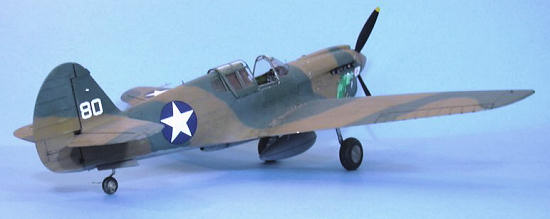 Using
road maps to find their way to Brisbane, the 7th
Squadron then used maritime maps to find their way up the Queensland coast.
Three of the P-40Es diverted to Charters Towers due to mechanical problems. The
nine remaining stayed overnight in Townsville, flying on to Iron Range airfield
on the 10th,
finally arriving at Horn Island at the tip of Cape York that afternoon. The next
day they began flying patrols within sight of the airfield.
Using
road maps to find their way to Brisbane, the 7th
Squadron then used maritime maps to find their way up the Queensland coast.
Three of the P-40Es diverted to Charters Towers due to mechanical problems. The
nine remaining stayed overnight in Townsville, flying on to Iron Range airfield
on the 10th,
finally arriving at Horn Island at the tip of Cape York that afternoon. The next
day they began flying patrols within sight of the airfield.
On March 10, Captain James Selman led 25 Kittyhawks of the 9th Pursuit Squadron from Williamtown to follow "The Brereton Route" to Darwin. They flew to Brisbane, where they left behind two P-40s with engine trouble, then flew on to Charleville where the 23 remaining Kittyhawks left behind two more aircraft with mechanical problems. 21 P-40Es pressed on for Cloncurry, led by a B-17. Two more were lost to heavy landings at Cloncurry. 19 P-40s flew on to Daly Waters on March 14, where four more aircraft became separated in heavy thunderstorms. 15 P-40s landed at Daly Waters between passing rain storms. A three day delay allowed needed repairs to be made to the P-40s.
Of the 25 P-40Es that had left Williamtown on March 10, 13 finally arrived at Darwin on March 18. They received orders to start operational patrols immediately. After assessing damage at Darwin airfield caused by the Japanese raids, the squadron moved to Batchelor airfield, 50 miles south. During the rest of March more Kittyhawks flew "The Brereton Route" to Darwin; by the end of the month the 9th PS had 21 Kittyhawks and 25 pilots. They were the front line of the defense of Australia.
The 49th officially entered combat on March 14,1942, when P-40s of the 7th Pursuit Squadron claimed 4 Zeros and 1 Betty in a raid on Horn Island. One P-40 rammed one of the Zeros and made a forced landing at Horn Island with 3 feet of its wingtip missing.
The biggest Japanese raid on Darwin came on
April 25, following three other attacks. 27 bombers 15 fighters with one
reconnaissance plane attacked the RAAF airfield on the o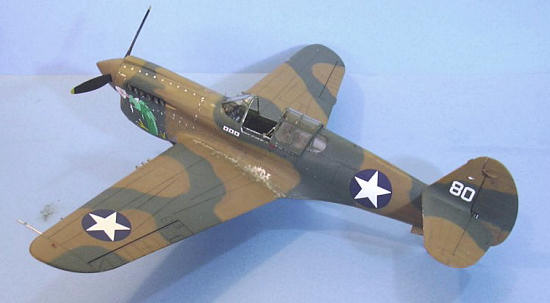 utskirts
of Darwin. This marked the first time all three squadrons of the 49th
operated together, claiming ten bombers and two fighters destroyed and one
bomber damaged against no P-40 losses. On April 28, the Japanese returned. The
49th
claimed victories over three bombers and four fighters, though 4 P-40s were
lost.
utskirts
of Darwin. This marked the first time all three squadrons of the 49th
operated together, claiming ten bombers and two fighters destroyed and one
bomber damaged against no P-40 losses. On April 28, the Japanese returned. The
49th
claimed victories over three bombers and four fighters, though 4 P-40s were
lost.
With a drop in raids in May and June, the 49th was able to increase its training, and to implement an advanced warning system using Australian coast watchers on Timor and the intervening islands, as would be established later in the Solomons. The development of this warning system led to the 49thís best day against the Japanese, which came on August 25, 1942, when 27 Betty bombers and 20 Zeros attacked. The Americans scored 9 Zeros and 4 Bettys without a loss.
During their time at Darwin, Kruzel was promoted to flight commander of Yellow Flight and took his wingman, Preddy, with him as the flight became known as the "Dragon Flight," with each of the four P-40Es carrying an elaborately-painted green dragon on the nose. Kruzelís P-40E-1 was distinguished from the others by carrying the dragon on both sides of the nose. This commemorated the P-40E Kruzel had flown in Java, which also had a dragon insignia, and in which he had scored three victories in February 1942. Preddy was joined as junior wingman by 2nd Lieutenant John D. Landers. Both had graduated from flight school the day Wurtsmith took command of the 49th and had joined at the Cow Palace. Kruzel quickly instructed his young pilots in what he had learned the hard way of flying a P-40 successfully in combat, and the flight soon became the most successful in the 9th Squadron. Kruzel did not score further during the fighting over Darwin and New Guinea.
Preddy was nearly killed on July 12, 1942, in a midair collision during combat. That fall, the Dragon flight was broken up as the now-experienced flight members moved up in the organization when the 49th flew on to Port Moresby in New Guinea, where they took on the experienced Japanese fighter pilots of the Tainan Fighter Wing, then based at Lae. Landers went on to become an ace with five victories by December 1942.
Following the completion of their tours, the original members of the 49th were returned to the United States, where they became valuable leaders in the new fighter groups being assembled for operations from England in the assault on Germany.
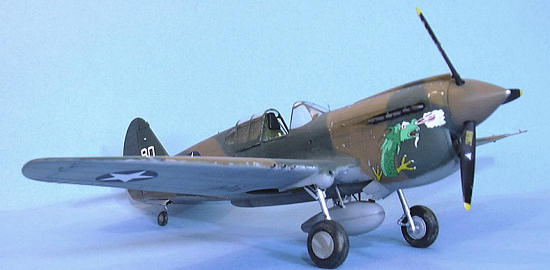 The
8th
Air Force would benefit tremendously from the early combat experience of these
young pilots. George Preddy went on to become the top-scoring P-51 Ace with the
352nd
Fighter Group before being killed by friendly fire on Christmas Eve, 1944. John
D. Landers helped form the 357th
Fighter Group and eventually commanded the 78th
Fighter Group. Sidney Woods - who cracked up his first P-40 while trying to fly
"the Brereton Route" to Darwin in March 1942 - revitalized the 4th
Fighter Group following the departure of the legendary Don Blakeslee and led the
former Eagles to become the top-scoring American fighter group of history in the
last six months of the war. Joe Kruzel became Deputy Group Commander of the 361st
Fighter Group, then assumed command of the unit following the death of Colonel
Thomas Christian, leading the unit from August 1944 to the end of the war,
during which time he scored 4 more victories against the Luftwaffe to become an
ace. Paul Wurtsmith was promoted Commander of 5th
Air Force Fighter Command under Major General George C. Kenney, and eventually
commanded the 13th
Air Force in 1945.
The
8th
Air Force would benefit tremendously from the early combat experience of these
young pilots. George Preddy went on to become the top-scoring P-51 Ace with the
352nd
Fighter Group before being killed by friendly fire on Christmas Eve, 1944. John
D. Landers helped form the 357th
Fighter Group and eventually commanded the 78th
Fighter Group. Sidney Woods - who cracked up his first P-40 while trying to fly
"the Brereton Route" to Darwin in March 1942 - revitalized the 4th
Fighter Group following the departure of the legendary Don Blakeslee and led the
former Eagles to become the top-scoring American fighter group of history in the
last six months of the war. Joe Kruzel became Deputy Group Commander of the 361st
Fighter Group, then assumed command of the unit following the death of Colonel
Thomas Christian, leading the unit from August 1944 to the end of the war,
during which time he scored 4 more victories against the Luftwaffe to become an
ace. Paul Wurtsmith was promoted Commander of 5th
Air Force Fighter Command under Major General George C. Kenney, and eventually
commanded the 13th
Air Force in 1945.
In the five months the 49th Fighter Group operated in the Northern Territory of Australia, they shot down 64 Japanese aircraft for the loss of 16 of their P-40s - a 4:1 victory ratio - set by young, inexperienced pilots in an outclassed airplane, flying against some of the best enemy pilots of the war.
| THE KIT |
The Hasegawa 1/32 P-40E has been eagerly awaited by modelers since the first surprise announcement of its release this past April. The only other 1/32 kit of this famous fighter is from Revell, and is now decidedly long in the tooth, having been first released over 35 years ago.
On opening the box, a modeler should not be surprised at the thought "Iíve been here before." Indeed, the kit is a scale-up of the 1/48 kit, with all that means for overall accuracy, detail, and fit.
First the bad news: Hasegawa saw fit to try and cut corners by releasing the kit with a windscreen that would be adaptable to later versions. Unfortunately, they not only screwed the pooch for the P-40E but also for any others, since they managed to mold in a clear vision panel on both sides, rather than only on the left. Since the framing is also done with engraved rather than raised detail, solving the problem is not easy. The good news is that if you start with a 400-grit sanding stick, then graduate to a 600-grit stick, then move on to Micro-Mesh pads of 2400, 3200, 4800, 6200 and 12,000-grit, you can over about 20-25 minutes, take the panel lines out of the windscreen and polish it out to the point that after a dip in Future, the old lines cannot be seen. A pain in the patootie? You bet. But not an unsolvable one.
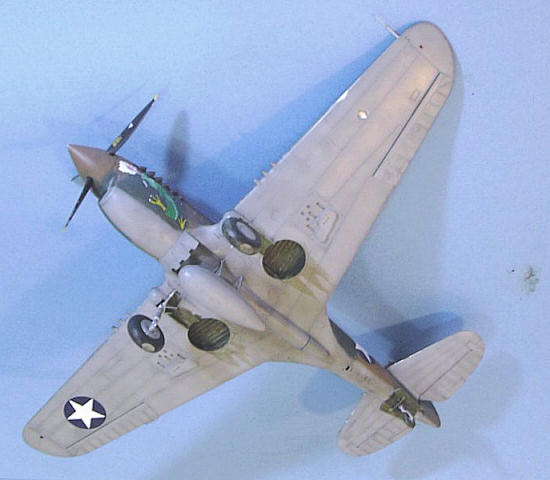 Having
heard from several other modelers that the kit seemed to have fit problems that
only magnified by size over those found on the 1/48 kit, I proceeded with some
test-fitting, which revealed that the problems are indeed there. However, with
careful fitting - as anyone who did more than one of the 1/48 kits learned - the
fit problems can be minimized to the point where an application of cyanoacrylate
glue over the seams, followed by careful sanding and a further application of
Mr. Surfacer, all these problems will disappear. Past that, the kit goes
together as easily as the smaller one did.
Having
heard from several other modelers that the kit seemed to have fit problems that
only magnified by size over those found on the 1/48 kit, I proceeded with some
test-fitting, which revealed that the problems are indeed there. However, with
careful fitting - as anyone who did more than one of the 1/48 kits learned - the
fit problems can be minimized to the point where an application of cyanoacrylate
glue over the seams, followed by careful sanding and a further application of
Mr. Surfacer, all these problems will disappear. Past that, the kit goes
together as easily as the smaller one did.
In fact, I was interested enough in the kit that I proceeded from test-fitting to actual assembly and found that the kit is indeed easy to assemble. I attached the "modular" parts before proceeding further - left tail half to left forward fuselage half, etc. - which allowed me to work on the joints from inside and out and get it as tight as possible. I did the fuselage as one completed sub-assembly and the wing as a completed sub-assembly. There are some issues with the upper wing-to-fuselage join, but nothing that cannot be solved with cyanoacrylate, sanding down, applying Mr. Surfacer and smoothing out.
The cockpit is detailed enough that only a Resinaholic will need to spend money for an aftermarket set. A very nice multi-part pilot figure is included. If you use this figure, you will not need to worry about seat harness. However, if you choose to keep the cockpit empty, do be aware that the P-40E-1 came out of the factory with U.S. seatbelts and harness, which was not replaced with the Sutton harness until the airplanes were delivered to the RAF or a Commonwealth air force, and even then they were not always flown with Sutton harnesses. Specifically, the two airplanes for which markings are provided in this kit are known to have had U.S. seatbelts, for which the Eduard multi-part seatbelt set is perfect for adding realism to the final result.
The kit provides decals with the correct-size national insignia and full stenciling. Individual markings are for two of the P-40E-1 version - otherwise known as Kittyhawk 1A - both taken on charge for U.S. Forces, with one being the P-40 flown by Ed Rector in the early days of the 23rd Fighter Group in the summer of 1942, and one being the well-known "Texas Longhorn" flown by Lt. John D. Landers of the 49th Fighter Group in the Southwest Pacific, also in 1942.
| CONSTRUCTION |
I found that - like the 1/48 kit - the major area of difficulty is the way in which the kit is broken down so as to facilitate future production of the P-40K, and the long-tail P-40F/L/M/N that are sure to come.
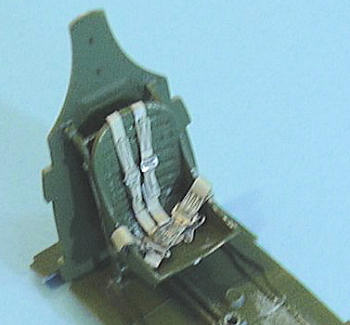 As with the
1/48 kit, neither the break between forward fuselage and tail, or the rear
cockpit area, attach on a panel line. I found that the best way to assemble the
fuselage was to attach the major parts - forward fuselage and rear fuselage - as
complete halves. This allowed me to work on the fit of those joints from both
sides, to get things lined up as closely as possible.
As with the
1/48 kit, neither the break between forward fuselage and tail, or the rear
cockpit area, attach on a panel line. I found that the best way to assemble the
fuselage was to attach the major parts - forward fuselage and rear fuselage - as
complete halves. This allowed me to work on the fit of those joints from both
sides, to get things lined up as closely as possible.
I then assembled the cockpit. I used Eduard USAAF seat belts for this. The P-40E-1, aka the "Kittyhawk I" - came out of the factory with US seat belts. The RAF Sutton harness was installed once delivered to the RAF. In Australia, there was a lack of time for all this, so both American units using "reverse Lend-Lease" Kittyhawks, as well as RAAF units, could find themselves using airplanes equipped with either the USAAF or RAF seatbelts, depending on whether the airplane had been through a maintenance depot before being issued to a squadron. The cockpit is very nice out of the box; installing the seatbelts (whichever you use) is all you really need to do here.
Once the fuselage was assembled, it was time to install the inner rear window plug and the clear parts. Getting rid of the seams for the cockpit window area and fuselage joints is tricky, and required me to use cyanoacrylate glue, followed by several coats of Mr. Surfacer 500, using a sanding stick to get a smooth surface while taking care not to sand away delicate surface detail. Once you have a seam like this apparently sanded away, itís a good idea to paint over the area, since seams tend to show up under paint. It took me three times to get rid of these seams, and the centerline seam of the fuselage also required more than one application of Mr. Surfacer to get rid of that line.
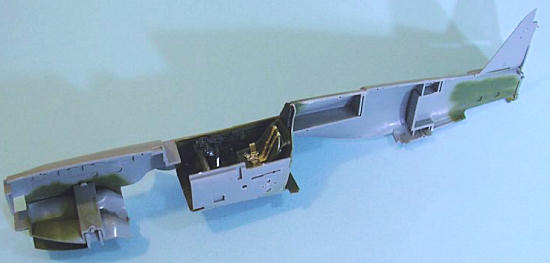 I spent
about 20 minutes correcting the windscreen. I started with a 600-grit sanding
stick to sand out the engraved detail, followed by an 800-grit sanding stick,
followed by breaking out the Micro-Mesh and using pads from 2400 mesh to 12000
mesh. The result was the complete disappearance of the mistake. Once Futured,
there was no indication the windscreen had ever been anything but right.
I spent
about 20 minutes correcting the windscreen. I started with a 600-grit sanding
stick to sand out the engraved detail, followed by an 800-grit sanding stick,
followed by breaking out the Micro-Mesh and using pads from 2400 mesh to 12000
mesh. The result was the complete disappearance of the mistake. Once Futured,
there was no indication the windscreen had ever been anything but right.
The various modular plugs fit better than they do with the 1/48 kit. Careful test-fitting will result in good fit, but I used cyanoacrylate glue on all those seams to make them disappear. Once these issues were dealt with, the kit assembled very easily.
Once the model was together, it was time to go to the paint shop.
| COLORS & MARKINGS |
Painting:
When one is doing a 49th
Fighter Group P-40E, the first question to get an answer for is - was it a
P-40E-1 or a Lend-Lease Kittyhawk Ia? All of the Kittyhawks with two color upper
camouflage are Lend-Lease airplanes that were taken over by the USAAF and
shipped to Australia. However, the group also received USAAC P-40E-1s from the
first three production batches. These are the airplanes in a single upper color.
One thing has confused researchers, since none of these airplanes has their
USAAC serial number on the vertical fin. This has led some to wonder if these
were not also RAF Kittyhawk Iaís, that were overpainted in a single upper color,
most likely Dark Earth. In the absence of color photos, an airplane in overall
Dark Earth or overall Olive Drab 41 will look the same i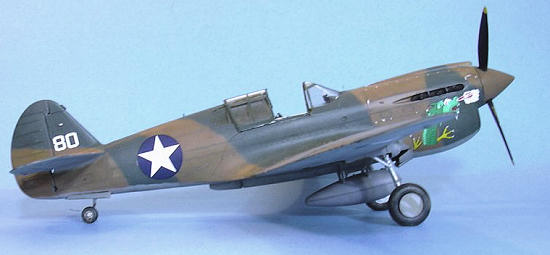 n
a black-and-white shot.
n
a black-and-white shot.
After preshading with flat black along panel lines, I painted the model freehand with Tamiya "Sky Grey" on the lower surfaces, and Gunze-Sangyo "Flat Earth" and "US Medium Green (FS34092)" for the "US equivalent colors" used on Kittyhawk Is. I sun-faded the model by lightening the upper colors with flat white and going over them/
Once this was done, I gave the model an overall coat of Future.
Decals:
The now out-of-production SuperScale sheet "49th Fighter Group" was used, thanks to Professor Charles Metz kindly providing the sheet. I used the stenciling from the kit decal sheet.
| FINAL CONSTRUCTION |
I washed off the model and gave it another coat of Future, followed by two coats of thinned Dullcote to give a flat, "sun-baked" finish. Photos of Kruzelís airplane show it with a minimum of "dinging," so I limited that to the fasteners for the cowling and the area along the wingwalk. Exhaust and gunfire stains were done with Tamiya "Smoke."
I then attached the landing gear, exhaust stacks, and prop, unmasked the canopies and attached the canopy slid back in the open position, and the 75-gallon drop tank.
| CONCLUSIONS |
Finally, a 1/32 P-40E that is as accurate as anyone could ask for, and presents no difficulties in assembly. Better yet, there is the promise of all the other Kittyhawk/Warhawk sub-types to come, to an equal standard. There will definitely be more of these in my collection, particularly as the aftermarket companies bring out more markings possibilities.
July 2008
Copyright ModelingMadness.com
Review kit courtesy of HobbyLink Japan - www.hlj.com
If you would like your product reviewed fairly and fairly quickly, please contact the editor or see other details in the Note to Contributors.